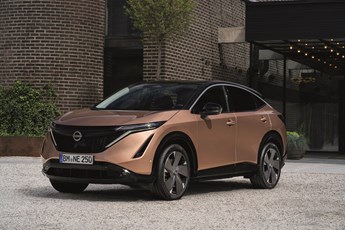We use cookies to ensure that we give you the best experience on our website. If you continue without changing your settings, we will assume that you are happy to receive all cookies on the Business Car website. However, if you would like to, you can change your cookies at any time

The start point for the best source of fleet information |
First drive: Nissan Ariya
Date: 16 August 2022 | Author: Pete Tullin

|
|
||||||||||||||||
Nissan effectively invented the crossover SUV back in 2007 with the first-generation Qashqai and subsequently dropped jaws around the world with its groundbreaking Leaf EV in 2010, so you have to wonder, what has taken it so long to combine the two concepts?
How much ground Nissan has lost to rival manufacturers because of this delay we'll never know, but that's history now, as the company sets about launching its futuristic-looking zero-emissions Ariya.
Available as a front-wheel drive model, powered by a 63 or 87kWh battery, or as a range-topping four-wheel-drive e-4ORCE version, prices start at £43,845 and top out at £56,290.
While the range potential for the entry model is around 250 miles, the larger battery cars are capable of over 300 miles and recharging times, although not exceptional, are pretty encouraging. Nissan reckons if you hook up a partially depleted battery to a 130kW DC motorway charger, with around 20% range remaining, a 30-minute zuzz should give you a boost of around 200 miles.
While you're waiting to re-energise, you'll have time to admire your surroundings. The cabin is neatly tailored, and has plenty of interesting design elements, including a row of dash-mounted haptic touchpoints to control the climate temperature, while Evolve models gain electrically controlled deployable dash tray and a powered sliding central armrest, which can be positioned to provide the perfect elbow resting point for effortless use of the dinky drive selector.
There are two 12.3in screens displaying infotainment and range information and if you're that way inclined you can configure the icons in order of preference. On top of this, higher spec cars gain a head-up display, delivering eye-level information including sat-nav directions, which is acknowledged as the safest way to visually assimilate information while driving.
As with many EVs, the Ariya's cabin has a completely flat floor, which is great for creating an impression of space and providing unsullied ankle room for middle rear passengers. That said, there are no footwells, so the seats have to be elevated to create some degree of hip-to-knee flex and as a knock on consequence, headroom is on the tight side - especially in cars fitted with a sunroof.
In terms of punch for your pounds, the entry car generates 218hp and the more vibrant 87kW versions 242hp, while the e-4ORCE model pumps out a feisty 305hp. More tellingly, it also develops 443lb/ft it of torque, which is twice as much as the standard cars, so if you like the idea of dusting off hot hatches and ripping marbles out of cat's eyes, look no further.
Right now, we've only driven the lower-powered version and although it's not blessed with hyperdrive, it's still rapid enough for effortless everyday motoring, with sufficient punch in reserve to deliver a strong burst of overtaking acceleration. It's also easy to drive smoothly and efficiently, especially once you've mastered the selectable e-pedal, which creates strong levels of deceleration simply by backing off the accelerator pedal.
As with most EVs, the Ariya's greatest dynamic challenge is controlling the enormous amount of weight the batteries add to proceedings. Trying to optimise the suspension to control masses, varying anywhere between 1.8 and 2.3t, depending on spec, while getting the vehicle to change direction with some kind of alacrity, and simultaneously providing the requisite levels of comfort, is a conundrum that no manufacturer has truly mastered, as yet. The Ariya comes close, but if anything, the control elements win out. Although the ride is seldom uncomfortable even at moderate speeds the suspension travel feels quite limited, so some impacts can be rather abrupt. As a motorway cruiser however, the Ariya's minimal drive train whine, low levels of wind and road noise will go a long way towards dialling out the stresses of elongated journeys to those far-flung business appointments.
Nissan Ariya Evolve 63kW
P11D: £47,785
Residual value: 43.46%
Depreciation: £27,015
Fuel: £4,007
Service, maintenance and repair: £1,800
Cost per mile: 55.36p
Range: 250 miles
CO2 (BIK %): 0% (2%)
BIK 20/40% a month: £15/£31
Luggage capacity: 466 litres
Battery size/power: 63kWh/218hp
Verdict |
8/10 |
|||
 |
|
 |
|
|











